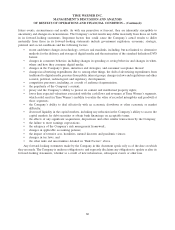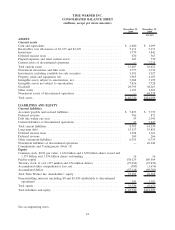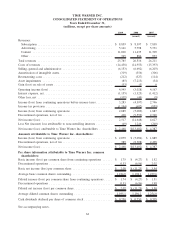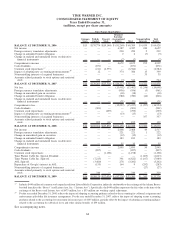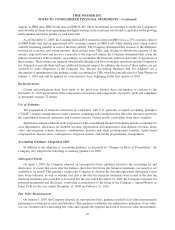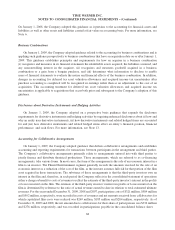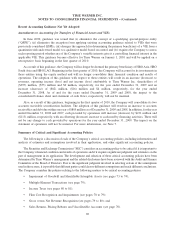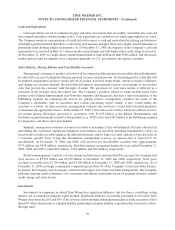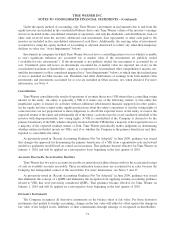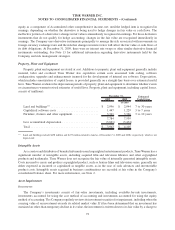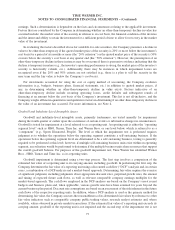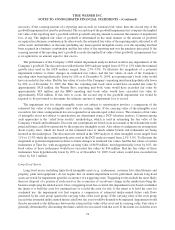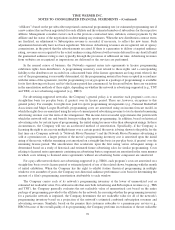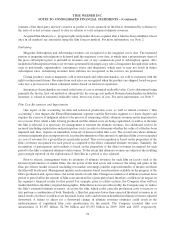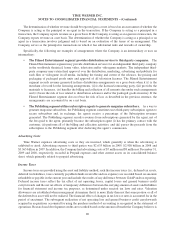Time Magazine 2009 Annual Report Download - page 82
Download and view the complete annual report
Please find page 82 of the 2009 Time Magazine annual report below. You can navigate through the pages in the report by either clicking on the pages listed below, or by using the keyword search tool below to find specific information within the annual report.Cash and Equivalents
Cash equivalents consist of commercial paper and other investments that are readily convertible into cash and
have original maturities of three months or less. Cash equivalents are carried at cost, which approximates fair value.
The Company monitors concentrations of credit risk with respect to cash and equivalents by placing such balances
with higher quality financial institutions or investing such amounts in liquid, short-term, highly-rated instruments or
investment funds holding similar instruments. As of December 31, 2009, the majority of the Company’s cash and
equivalents were invested in Rule 2a-7 money market mutual funds and with banks with a credit rating of at least A.
At December 31, 2009, no single money market mutual fund or bank held more than $500 million, and the money
market mutual fund investments were comprised primarily of U.S. government and agency securities.
Sales Returns, Pricing Rebates and Uncollectible Accounts
Management’s estimate of product sales that will be returned and the amount of receivables that will ultimately
be collected is an area of judgment affecting reported revenues and net income. In estimating product sales that will
be returned, management analyzes vendor sell-off of product, historical return trends, current economic conditions,
and changes in customer demand. Based on this information, management reserves a percentage of any product
sales that provide the customer with the right of return. The provision for such sales returns is reflected as a
reduction in the revenues from the related sale. The Company’s products subject to return include home video
product at the Filmed Entertainment and Networks segments and magazines and direct sales merchandise at the
Publishing segment. In estimating the reserve for pricing rebates, management considers the terms of the
Company’s agreements with its customers that contain purchasing targets which, if met, would entitle the
customer to a rebate. In those instances, management evaluates the customer’s actual and forecasted purchases
to determine the appropriate reserve. At December 31, 2009, total reserves for returns (which also reflects reserves
for certain pricing allowances provided to customers) were $1.493 billion at the Filmed Entertainment and
Networks segments primarily related to film products (e.g., DVD sales) and $387 million at the Publishing segment
for magazines and direct sales merchandise.
Similarly, management evaluates accounts receivable to determine if they will ultimately be fully collected. In
performing this evaluation, significant judgments and estimates are involved, including management’s views on
trends in the overall receivable agings at the different divisions, and for larger accounts, analyses of specific risks on
a customer specific basis. Using this information, management reserves an amount that is expected to be
uncollectible. At December 31, 2009 and 2008, total reserves for uncollectible accounts were approximately
$373 million and $438 million, respectively. Bad debt expense recognized during the years ended December 31,
2009, 2008 and 2007 totaled $87 million, $122 million and $70 million, respectively.
Based on management’s analyses of sales returns and allowances and uncollectible accounts, the Company had
total reserves of $2.253 billion and $2.229 billion at December 31, 2009 and 2008, respectively. Total gross
accounts receivable were $7.364 billion and $7.400 billion at December 31, 2009 and 2008, respectively. As of
December 31, 2009, no single counterparty comprised greater than 5% of the Company’s total receivables balance.
In general, the Company does not require collateral with respect to its trade receivable arrangements. The Company
performs ongoing credit evaluations of its customers and adjusts credit limits based on payment histories, current
credit ratings and other factors.
Investments
Investments in companies in which Time Warner has significant influence, but less than a controlling voting
interest, are accounted for using the equity method. Significant influence is generally presumed to exist when Time
Warner owns between 20% and 50% of the investee, holds substantial management rights or holds an interest of less
than 20% where the investee is a limited liability partnership or limited liability corporation that is treated as a flow-
through entity.
70
TIME WARNER INC.
NOTES TO CONSOLIDATED FINANCIAL STATEMENTS – (Continued)


